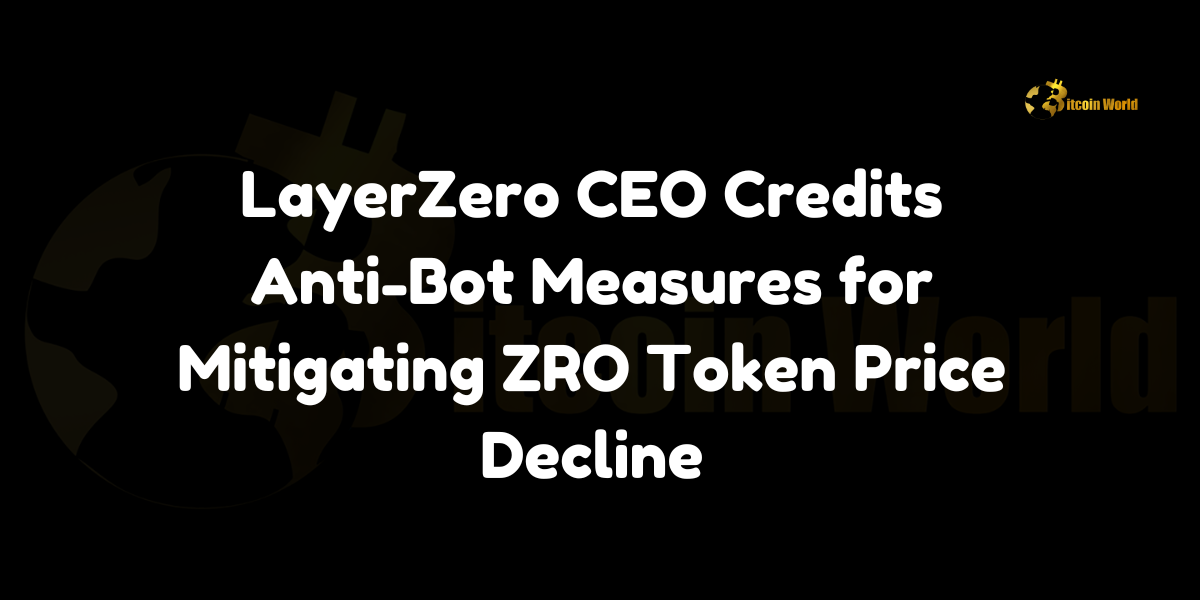LayerZero Labs CEO, Bryan Pellegrino, has attributed the relatively stable performance of the project’s native ZRO token to the implementation of effective anti-bot measures, as reported by Cointelegraph. Since its launch on June 20, the ZRO token has seen a price decline of only 23%, a significantly better performance compared to similar tokens from ZKsync and Starknet. Pellegrino emphasized that LayerZero’s focus on rewarding dedicated users, combined with strong Sybil and bot filtering, has contributed to the token’s resilience in a challenging market.
In comparison, Starknet’s STRK token has plummeted by over 91%, and ZKsync’s ZK token has dropped by 67%, with both projects facing criticism for insufficient bot filtering and declining user activity.
Despite facing some criticism for requiring a donation to claim the airdropped tokens, the ZRO token has managed to outperform many of its peers, especially in the face of declining user activity across the broader market. The implementation of robust anti-bot measures has helped LayerZero maintain a more engaged and authentic user base, thereby reducing sell pressure and contributing to a more controlled price decline.
Effective Anti-Bot Measures and Dedicated User Focus
Pellegrino pointed out that LayerZero’s strategy of filtering out bots and Sybil attackers was key to the project’s success. By preventing bots from claiming airdropped tokens and ensuring that only genuine, dedicated users were rewarded, the project was able to avoid a sudden influx of tokens being sold off by opportunistic traders. This careful approach to distribution helped mitigate the volatility often seen in newly launched tokens.
In contrast, other projects, such as Starknet and ZKsync, have struggled with Sybil attacks and bot-driven claims, which have contributed to more severe declines in token value. Starknet’s STRK token, in particular, has seen a dramatic 91% drop in value, largely due to declining user activity and ineffective Sybil filtering.
Criticism Over Airdrop Claiming Process
While LayerZero’s anti-bot measures have been credited with stabilizing the ZRO token, the project did face criticism for requiring users to make a donation in order to claim their airdropped tokens. Some users felt this additional step was an unnecessary barrier, but Pellegrino defended the decision, stating that it was part of a broader effort to ensure that only committed participants, rather than bots or speculators, received tokens.
This approach aligns with LayerZero’s philosophy of rewarding long-term users who contribute to the network, rather than those who are solely looking to capitalize on a quick token sale.
Comparison with Starknet and ZKsync Tokens
The stark difference in performance between LayerZero’s ZRO token and those of Starknet and ZKsync highlights the importance of effective bot mitigation and user engagement strategies in the success of token launches. Starknet’s STRK token, which has fallen by over 91%, has suffered from a steep decline in user activity, while ZKsync’s ZK token has dropped by 67%, with both projects facing challenges in filtering out Sybil attackers.
ZKsync’s inadequate Sybil filtering has been particularly criticized, with many pointing out that the project’s failure to implement effective anti-bot measures resulted in a large number of tokens being claimed by bots or Sybil attackers, leading to increased sell pressure and a rapid decline in token value.
ZRO’s Long-Term Prospects
Despite the 23% decline in the ZRO token’s value since its launch, the project’s long-term outlook remains positive. LayerZero’s commitment to maintaining an authentic user base and filtering out bots has created a more sustainable growth model compared to its peers. Pellegrino’s focus on rewarding dedicated users rather than speculators is expected to contribute to the project’s long-term stability, as it builds a more engaged community around the LayerZero ecosystem.
As LayerZero continues to evolve, the project’s ability to maintain these principles while scaling its user base will be crucial in determining the future performance of the ZRO token.
Conclusion
LayerZero’s ZRO token has outperformed similar tokens from projects like ZKsync and Starknet due to its effective anti-bot measures and focus on rewarding genuine users. While the token has faced a 23% price decline since its June launch, this is relatively modest compared to the severe drops seen by STRK and ZK. By implementing strong Sybil filtering and focusing on long-term user engagement, LayerZero has managed to stabilize the ZRO token and build a foundation for future growth.
Internal Links for Reference
To learn more about the innovative startups shaping the future of the crypto industry, explore our article on latest news, where we delve into the most promising ventures and their potential to disrupt traditional industries.
Disclaimer: The information provided is not trading advice, Bitcoinworld.co.in holds no liability for any investments made based on the information provided on this page. We strongly recommend independent research and/or consultation with a qualified professional before making any investment decisions.



